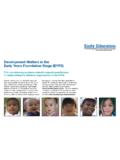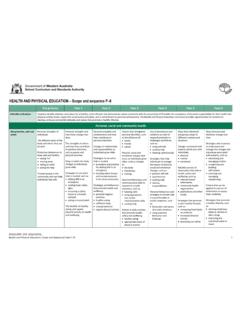Transcription of The Association Between School-Based Physical Activity ...
1 The Association Between School-Based Physical Activity , Including Physical Education, and Academic Performance Department of Health and Human Services Centers for Disease Control and Prevention National Center for Chronic Disease Prevention and Health Promotion Division of Adolescent and school Health Revised Version July 2010 (Replaces April 2010 Early Release) - - Acknowledgments: This publication was developed for the Centers for Disease Control and Prevention s (CDC) Division of Adolescent and school Health (DASH) under contract #200 2002-00800 with ETR Associates. Suggested Citation: Centers for Disease Control and Prevention. The Association Between school based Physical Activity , including Physical education, and academic performance.
2 Atlanta, GA: Department of Health and Human Services; 2010. TABLE OF CONTENTS Executive Summary . 5 Introduction . 8 Methods 10 Conceptual Definitions . 10 Inclusion Criteria . 10 Identification of Studies that Met the Inclusion Criteria.
3 11 Classification of Studies . 11 Study Coding Process . 12 Data Analysis . 13 Results . 14 School-Based Physical Education Studies . 16 Recess Studies.
4 19 Classroom Physical Activity Studies . 21 Extracurricular Physical Activity Studies . 24 Summary . 28 Overall Findings . 28 Findings for Physical Activity by Context . 29 Findings by Gender, Other Demographic Characteristics, and Research Design.
5 30 Strengths and Limitations of Review . 30 Implications for Future Research or Evaluation . 31 Implications for Schools . 32 References . 34 Appendices . 39 Appendix A: Database Search Terms.
6 39 Appendix B: Coding Sheet . 41 Appendix C: Glossary of Research Design Terms . 51 Appendix D: School-Based Physical Education Summary Matrix . 52 Appendix E: Recess Summary Matrix . 62 Appendix F: Classroom Physical Activity Summary Matrix . 67 Appendix G: Extracurricular Physical Activity Summary Matrix.
7 73 The Association Between School-Based Physical Activity , Including Physical Education, and Academic Performance | 3 EXECUTIVE SUMMARY When children and adolescents participate in the recommended level of Physical Activity at least 60 minutes daily multiple health
8 Benefits accrue. Most youth, however, do not engage in recommended levels of Physical Activity . Schools provide a unique venue for youth to meet the Activity recommendations, as they serve nearly 56 million youth. At the same time, schools face increasing challenges in allocating time for Physical education and Physical Activity during the school day. There is a growing body of research focused on the Association Between School-Based Physical Activity , including Physical education, and academic performance among school -aged youth. To better understand these connections, this review includes studies from a range of Physical Activity contexts, including School-Based Physical education, recess, classroom- based Physical Activity (outside of Physical education and recess), and extracurricular Physical Activity .
9 The purpose of this report is to synthesize the scientific literature that has examined the Association Between School-Based Physical Activity , including Physical education, and academic performance, including indicators of cognitive skills and attitudes, academic behaviors, and academic achievement. Methods For this review, relevant research articles and reports were identified through a search of nine electronic databases, using both Physical Activity and academic-related search terms. The search yielded a total of 406 articles that were examined to determine their match with the inclusion criteria. Forty-three articles (reporting a total of 50 unique studies) met the inclusion criteria and were read, abstracted, and coded for this synthesis.
10 Coded data from the articles were used to categorize and organize studies first by their Physical Activity context ( , Physical education, recess, classroom- based Physical Activity , and extracurricular Physical activities), and then by type of academic performance outcome. Academic performance outcomes were grouped into three categories: 1) academic achievement ( , grades, test scores); 2) academic behavior ( , on-task behavior, attendance); and 3) cognitive skills and attitudes ( , attention/concentration, memory, mood). Findings of the 43 articles that explored the relationship Between indicators of Physical Activity and academic performance were then summarized. Results Across all 50 studies (reported in 43 articles), there were a total of 251 associations Between Physical Activity and academic performance, representing measures of academic achievement, academic behavior, and cognitive skills and attitudes.











